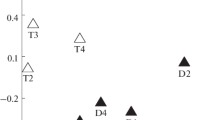Abstract
Bacterioplankton community composition was studied in 12 lakes in three dierent geographic regions in Scandinavia using denaturing gradient gel electrophoresis (DGGE) and sequencing of 16S rDNA. Area-specific abundant taxa were found in the lakes in two of the regions. In the region of Uppland the lakes had an α-proteobacterium, belonging to the subgroup Alpha V in common. The Alpha V bacteria appeared to be favored by neutral or higher pH values. The lakes in Lappland were found to harbor Actinobacteria, which appeared to be favored in bog lakes. No abundant taxon was found to be in common for the lakes in Svalbard, the third region studied.
Similar content being viewed by others
References
Bahr M, Hobbie JE, Sogin ML (1996) Bacterial diversity in an arctic lake: a freshwater SAR11 cluster. Aquat Microb Ecol 11:271–277
Blomqvist P, Jansson M, Drakare S, Bergström A-K, Brydsten L (2001) Effects of additions of DOC on pelagic biota in a clearwater system-results from a whole lake experiment in northern Sweden. Microb Ecol 42:383–394
Brunberg A-K, Blomqvist P (1998) Vatten i Uppsala län 1997. Rep. 8/1998, Upplandsstiftelsen
Casamayor EO, Schäfer H, Baneras L, Pedrós-Alió C, Muyzer G (2000) Identification of and spatio-temporal differences between microbial assemblages from two neighboring sulfurous lakes: comparison by microscopy and denaturing gradient gel electrophoresis. Appl Environ Microbiol 66:499–508
Glöckner FO, Amann R, Alfreider A, Pernthaler J, Psenner R, Trebesius K, Schleifer K-H (1996) An in situ hybridization protocol for detection and identification of planktonic bacteria. System Appl Microbiol 19:403–406
Glöckner FO, Fuchs BM, Amann R (1999) Bacterioplankton composition of lakes and oceans: a first comparison based on fluorescence in situ hybridisation. Appl Environ Microbiol 65:3721–3726
Glöckner FO, Zaichikov E, Belkova N, Denissova L, Pernthaler J, Pernthaler A, Amann R (2000) Comparative 16S rRNA analysis of lake bacterioplankton reveals globally distributed phylogenetic clusters including an abundant group of Actinobacteria. Appl Environ Microbiol 66:5053–5065
Higgins DG, Bleasby AJ, Fuchs R (1992) CLUSTAL V: improved software for multiple sequence alignment. Comput Appl Biosci 8:189–191
Jansson M, Bergström A-K, Drakare S, Blomqvist P (2001) Nutrient limitation of bacterioplankton and phytoplankton in humic lakes in northern Sweden. Freshwat Biol 46:653–666
Kimura M (1980) A simple method for estimating evolutionary rate of base substitution through comparative studies of nucleotide sequences. J Mol Evol 16:111–120
Konopka A, Bercot T, Nakatsu C (1999) Bacterioplankton community diversity in a series of thermally stratified lakes. Microb Ecol 38:126–135
Kumar S, Tamura K, Nei M (1993) MEGA: Molecular evolutionary genetics analysis, version 1.01. The Pennsylvania State University, University Park, PA
Lane DJ, Pace B, Olsen GJ, Stahl DA, Sogin ML, Pace NR (1985) Rapid determination of 16S ribosomal RNA sequences for phylogenetic analyses. Proc Natl Acad Sei USA 82:6955–6959
Lindström ES (1998) Bacterioplankton community composition in a boreal forest lake. FEMS Microbiol Ecol 27:163–174
Lindström ES (2000) Bacterioplankton community composition in five lakes differing in trophic status and humic content. Microb Ecol 40:104–113
Lindström ES (2001) Investigating influential factors on bacterioplankton community composition-results from a field study of five mesotrophic lakes. Microb Ecol 42:598–605
Methé BA, Hiorns WD, Zehr JP (1998) Contrasts between marine and freshwater bacterial community composition: analyses of communities in Lake George and six other Adirondack lakes. Limnol Oceanogr 43:368–374
Methé BA, Zehr JP (1999) Diversity of bacterial communities in Adirondack lakes: do species assemblages reflect lake water chemistry? Hydrobiologia 401:77–96
Mullins TD, Britschgi TB, Krest RL, Giovannoni SJ (1995) Genetic comparisons reveal the same unknown bacterial lineages in Atlantic and Pacific bacterioplankton communities. Limnol Oceanogr 40:148–158
Muyzer G, Smalla C (1998) Application of denaturing gradient gel electrophoresis (DGGE) and temperature gradient gel electrophoresis (TGGE) in microbial ecology. Antonie van Leeuwenhoek 73:127–141
Pinhassi J, Hagström Å (2000) Seasonal succession in marine bacterioplankton. Aquat Microb Ecol 21:245–256
Rappé MS, Vergin K, Giovannoni SJ (2000) Phylogenetic comparisons of a coastal bacterioplankton community with its counterparts in open ocean and freshwater systems. FEMS Microbiol Ecol 33:219–232
Schauer M, Massana R, Pedrós-Alió C (2000) Spatial differences in bacterioplankton composition along the Catalan coast (NW Mediterranean) assessed by molecular fingerprinting. FEMS Microbiol Ecol 33:51–59
Simek K, Babenzien D, Bittl T, Koschel R, Macek M, Nedoma J, Vrba J (1998) Microbial food webs in an artificially divided acidic bog lake. Internat Rev Hydrobiol 83:3–18
Stackebrandt E, Rainey FA, Ward-Rainey NL (1997) Proposal for a new hierarchic classification system, Actinobacteria classis nov. Int J Syst Bacteriol 47:479–491
Swofford DL (1993) PAUP: Phylogenetic analysis using parsimony, Version 3.1. Computer program distributed by the Illinois Natural History Survey, Champaign, IL
Torsvik V, Daae FL, Sandaa R-A (1998) Novel techniques for analysing microbial diversity in natural and perturbed environments. J Biotechnol 64:53–62
Urbach E, Vergin KL, Young L, Morse A, Larson GL, Giovannoni SJ (2001) Unusual bacterioplankton community structure in ultra-oligotrophic Crater Lake. Limnol Oceanogr 46:557–572
Zwart G, Hiorns WD, Methé BA, van Agterveld MP, Huisman R, Nold SC, Zehr JP, Laanbroek HJ (1998) Nearly identical 16S rRNA sequences recovered from lakes in North America and Europe indicate the existence of clades of globally distributed freshwater bacteria. System Appl Microbiol 21:546–556
Ørbæk JB, Svenøe T, Hessen DO (2001) Spectral properties and UV attenuation in Arctic freshwater systems. In: OD Hessen (ed) UV Radiation and Arctic Ecosystems. Ecological series 153. Springer Verlag, New York 57–72
Øvreås L, Forney L, Daae FL, Torsvik V (1997) Distribution of bacterioplankton in meromictic Lake Sælenvannet, as determined by denaturing gradient gel electrophoresis of PCR-amplified gene fragments coding for 16S rRNA. Appl Environ Microbiol 63:3367–3373
Author information
Authors and Affiliations
Corresponding author
Additional information
Online publication: 20 May 2002
Rights and permissions
About this article
Cite this article
Lindström, E.S., Leskinen, E. Do neighboring lakes share common taxa of bacterioplankton? Comparison of 16S rDNA fingerprints and sequences from three geographic regions. Microb Ecol 44, 1–9 (2002). https://doi.org/10.1007/s00248-002-0007-6
Received:
Accepted:
Issue Date:
DOI: https://doi.org/10.1007/s00248-002-0007-6



